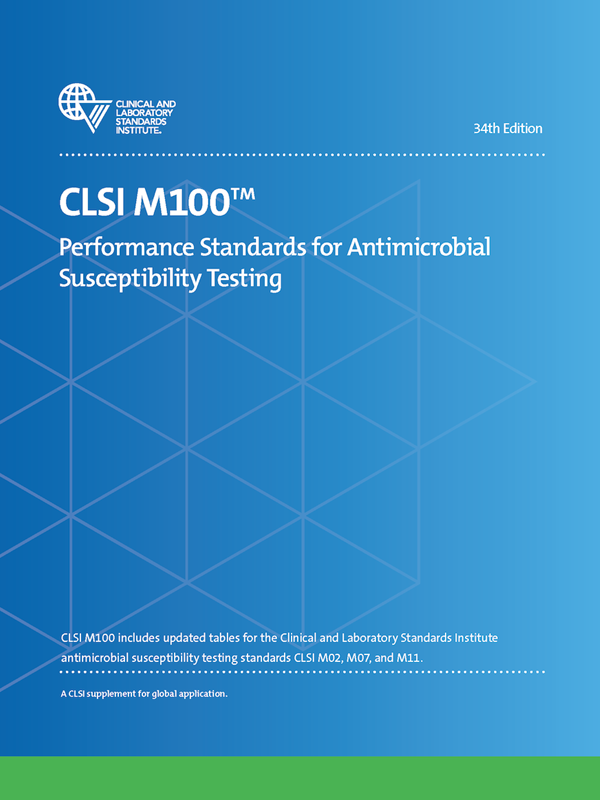CLSI AST Standards: New Guidelines Help Slow Spread of Antimicrobial Resistance
5/9/2024

CLSI recently published the 34th edition of CLSI M100—Performance Standards for Antimicrobial Susceptibility Testing, as well as new editions of standards documents, CLSI M02 and CLSI M07.1, 2, 3 Using guidance like CLSI M100, M02, and M07 can help slow the spread of antimicrobial resistance (AMR), one of the leading global public health and development threats.
AMR occurs when microorganisms evolve, making previously effective drugs ineffective. In extreme cases, pathogens develop resistance to a wide array of antimicrobials, a phenomenon known as multidrug resistance. AST documents like CLSI M100, M02, and M07 include recommendations for selecting suitable agents for testing, interpreting results, and reporting, and are updated and released regularly to ensure clinical microbiologists provide the most accurate AST results possible. The result? Health care providers are able to prescribe the most appropriate antimicrobial treatments to patients.
The price of unfettered AMR is steep. It’s estimated that bacterial AMR was directly responsible for 1.27 million global deaths in 2019 and was a contributing factor to an additional 4.95 million deaths. The misuse and overuse of antimicrobials in humans, animals, and plants are the main drivers in the development of drug-resistant pathogens.4 AMR also incurs significant economic costs. The World Bank estimates that AMR could result in US$ 1 trillion additional healthcare spending by 2050, and US$ 1 trillion to US$ 3.4 trillion gross domestic product (GDP) losses per year by 2030.5
The development of appropriate AST practices and guidance, such as that articulated in CLSI M100, M02, and M07, involves a collaborative effort by a diverse group of subject matter experts. Together they form the CLSI Antimicrobial Susceptibility Testing Subcommittee, which is further divided into specialized working groups. Each group focuses on specific elements of AST, like selecting antimicrobials for testing against certain bacteria, setting breakpoints for new drugs, and establishing quality control measures.
When analyzing bacterial cultures, clinical microbiologists first attempt to pinpoint the organism(s) at the root of a patient’s infection. If the organism’s response to potential antimicrobials is uncertain, the lab conducts AST using various available methods. The findings are then interpreted using CLSI M100 breakpoint criteria, enabling the lab to advise health care providers on potentially effective treatments. Using CLSI AST standards in the microbiology lab enhances patient care and helps combat antimicrobial resistance. By adopting and integrating the latest standards, clinical microbiology labs can promote responsible antimicrobial use and play a crucial role in the worldwide effort to curb antimicrobial resistance.
Equip your lab to take part in the AMR fight. CLSI M100, M02, and M07 are available as a package and are also available for group purchase at a bulk rate. For more information on group purchases, contact customer service at customerservice@clsi.org or +1.610.688.0100.
References
- Performance Standards for Antimicrobial Susceptibility Testing. 34th ed. CLSI supplement M100. Clinical and Laboratory Standards Institute; 2024.
- Performance Standards for Antimicrobial Disk Susceptibility Tests. 14th ed. CLSI standard M02. Clinical and Laboratory Standards Institute; 2024.
- Methods for Dilution Antimicrobial Susceptibility Tests for Bacteria That Grow Aerobically. 12th ed. CLSI standard M07. Clinical and Laboratory Standards Institute; 2024.
- Antimicrobial Resistance. https://www.who.int/news-room/fact-sheets/detail/antimicrobial-resistance. Accessed on April 29, 2024.
- The World Bank. Drug-Resistant Infections: A Threat to Our Economic Future. https://www.worldbank.org/en/topic/health/publication/drug-resistant-infections-a-threat-to-our-economic-future. Accessed April 29, 2024.
